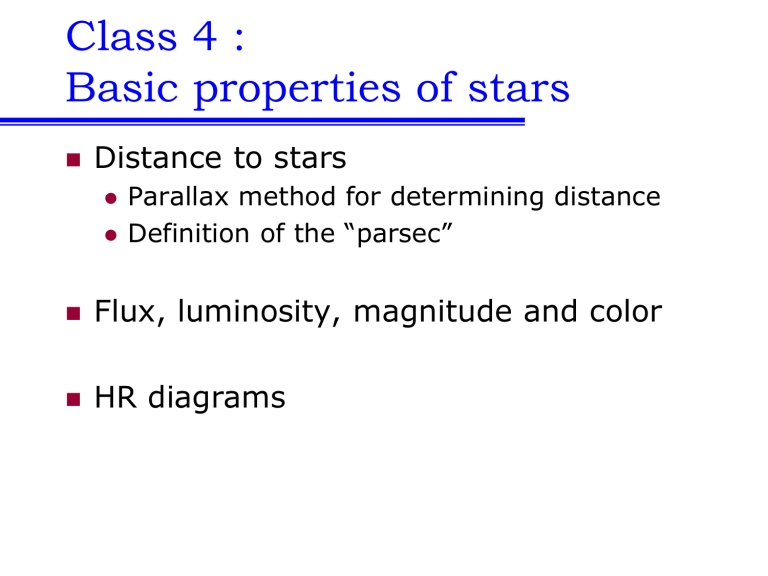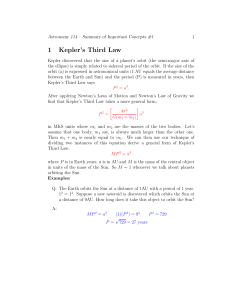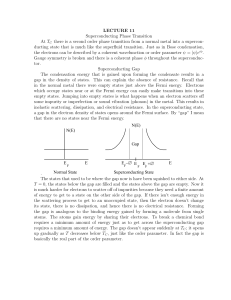
Class 4 : Basic properties of stars Distance to stars Parallax method for determining distance Definition of the “parsec” Flux, luminosity, magnitude and color HR diagrams I : The distance to the stars The distance to any astronomical object is the most basic parameter we want to know Require knowledge of distance in order to calculate just about any other property of the object Distance is often difficult to determine! Most direct method for measure distances to “nearby” stars uses an effect called parallax As Earth orbits Sun, we view a star along a slightly different line of sight This causes the star to appear to move slightly with respect to much more distant stars We can currently use this technique to measure stellar distances out to ~3000 light years from Earth If star displays parallax of =1arcsec, then distance D is given by This distance is called a parsec and is a commonly used unit of distance in astronomy In general, if a star displays a parallax of , then its distance is II : Flux and luminosity Definition : The observed flux of a star is the energy received from the star per unit time per unit area. The area under consideration must be oriented face-on to lineof-sight to the star In principle, this definition works for any kind of energy emitted by the star… most commonly, we mean e/m radiation Sometimes, it is useful to consider the observed flux in a restricted range of e/m wavelengths (e.g., the “optical flux” or “X-ray flux”, or “500-600nm flux”) Definition : The luminosity of a star is the energy per unit time (i.e. power) emitted by the star Again, this can apply to any kind of energy but we will usually mean e/m radiation Again, it is sometimes useful to consider the luminosity in a restricted range of e/m wavelengths Suppose a star emits equally in all directions (ie the emission is isotropic) and is steady in time. Then, if D is the distance to the star, observed flux F and luminosity L and related according to: Inverse square law for flux III : Stellar magnitudes 2000 years ago, Hipparcus ranked the apparent brightness of stars according to “magnitudes”… 1st magnitude - brightest stars in sky 2nd magnitude - bright but not brightest … 6th magnitude - faintest stars visible to human eye This system is based on visual perception (which is a logarithmic system)… mag 1 is factor of f brighter than mag 2 mag 2 is factor of f brighter than mag 3 THUS, mag 1 is factor of f2 brighter than mag 3 Modern definition: If two stars have fluxes F1 and F2, then their apparent magnitudes m1 and m2 are given by Notes The star Vega is defined to have an apparent magnitude of zero! This allows one to talk about the apparent magnitude of a given star rather than just differences in apparent magnitudes Value of constant k set by reference to Vega Higher apparent magnitudes, are fainter stars! A difference of 5 magnitudes corresponds to a factor of 100 in flux Brightest star (Sirius) has m=-1.44 Faintest stars visible to human eye have m=6.5 Sun has m=-26.7 Full Moon has m=-12.6 Venus at its brightest m=-4.7 Pluto has m=13.65 Faintest object visible by Hubble Space Telescope is m=30 Definition : The absolute magnitude (M) of a star is its apparent magnitude if it were placed at a distance of 10pc. If star is at distance D, we get The quantity m-M is called the distance modulus All of this sounds complicated… but just keep in mind that: Apparent magnitude flux Absolute magnitude luminosity Distance modulus distance IV : Colors “Traditional” astronomers often observe using filters that only allow a certain range fo wavelengths through. Common “bands” are U B V R K - ultraviolet blue visual red near infrared So we can measure the apparent magnitude of a give star in different filters… mB, mV, mR etc. We then define color indices by taking differences of the magnitudes measured in the different filters… U-B=mU-mB, B-V=mB-mV etc. Confused? Color index stellar temperature Question : Is B-V<0 a blue or red star, and what is the reference point? How does this change with distance? V : Spectral types Stellar spectra possess much more information than simple color… the presence/strengths of the absorption lines characterize the nature of the outer layers of the star In 1901, Annie Cannon showed that stars can be classified into seven groups (spectral-type) according to strengths of absorption lines: O B A F G K M Each spectral-type is subdivided into 10 subclasses: A0,A1,A2,A3,…,A9 Sun is a G2 star In 1921, Cecilia Payne showed that all stars are composed mostly of H and He; spectral differences reflect differences of temperature, not composition VI : Patterns in the properties of stars Consider the following experiment… Find a star cluster so that you know that all stars are at approximately the same distance from Earth Measure apparent magnitude and colors of the stars Plot these two quantities against each other This is a Hertzsprung-Russell diagram What would you expect??? Despite all of the potential complexities, most stars lie on a single line in this diagram! The rest inhabit very specific lines/regions. What underlies this surprising simplicity? All stars have basically the same composition 75% H, 24%He, 1% everything else Once born, stars “forget” environment they were born in So… only mass and age matter.







